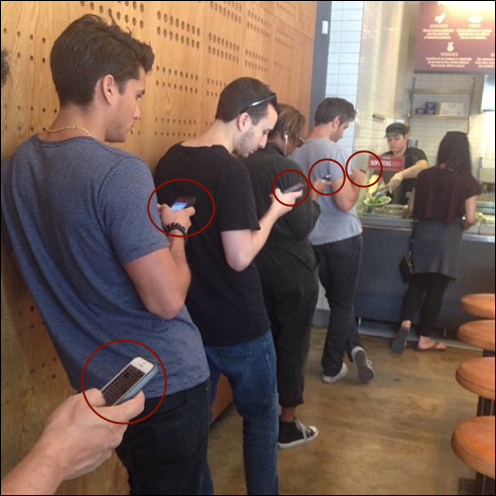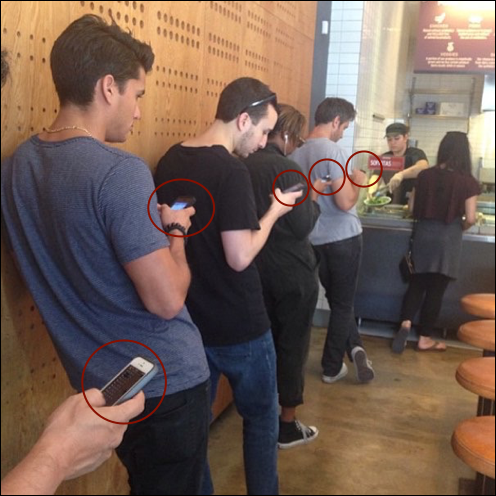Which is more valuable? Shortening the perception of wait time or shortening the actual wait time? It's hard to choose one or the other without considering things like cost or resources needed. Regardless, this seems to be a recurring theme for executives at top performing Fast Casual and Quick Service Restaurant brands. Today's top restaurant brands are fulfilling consumers' desires for quality food, sometimes at the cost of longer wait times. While it's not ideal to have customer dwell time increase in a Fast Casual setting, it may be a good business decision to keep the longer wait if it means higher quality food or service. Instead of trying to figure out ways to reduce wait time by cutting steps in your food preparation/delivery process, why not try and reduce the perception of wait time while still engaging customers with your brand?
Rory Sutherland, Executive Creative Director of OgilvyOne and regarded as one of marketing and advertising's most original thinkers and inspirational speakers, shares a great anecdote.
"You know my example of the Eurostar. Six million pounds spent to reduce the journey time between Paris and London by about 40 minutes. For 0.01 percent of this money you could have put WiFi on the trains, which wouldn't have reduced the duration of the journey, but would have improved its enjoyment and its usefullness far more. For maybe 10% of the money, you could have paid all of the worlds top male and female supermodels to walk up and down the train handing out free Chateau Petrus to all the passengers. You'd still have five [million] pounds in change, and people would ask for the trains to be slowed down."
Watch the whole TED talk here.
He makes a great point. Stop looking at how you can change process to speed things up, which often comes with a high price tag, and start looking at what you can implement to make wait time more enjoyable for your customers. As another anecdote, below is a candid picture of customers waiting in line for Chipotle.
 If most pictures speak 1,000 words, this speaks 10 times that. Consumers do not like to be bored and our mobile phones are one of the, if not the most common, ways we choose to occupy ourselves while waiting in line. The problem here is that more often than not, consumers who are in-store on their mobile phone are not using it to engage with the brand.
If most pictures speak 1,000 words, this speaks 10 times that. Consumers do not like to be bored and our mobile phones are one of the, if not the most common, ways we choose to occupy ourselves while waiting in line. The problem here is that more often than not, consumers who are in-store on their mobile phone are not using it to engage with the brand.
We came up with three ways you can improve the perceived wait time at your store while still encouraging customers to interact with your brand:
- Entertain them with music: Rockbot allows you to engage customers how they want to be engaged, through music! In a recent study with Technomic, we found that more than three out of four consumers (78%) said that listening to music was important or very important in entertaining them in restaurants. Customers can use Rockbot's app to browse music, sync their spotify account and vote up and down on a queue of songs picked by staff or other customers. Meanwhile, brands are able to choose their own customized catalog of music to make sure the music playing is always representative of their values.
- Fill them in on expected wait time and encourage them to use the mobile app next time to pre-order: Use wait time to promote use of your app and online ordering capabilities. In a study by OpenTable, they uncovered that 85% of diners wish they knew how long the wait for a table would be ahead of time. Consumers tend to be happier when they understand how much time they will have to invest. Not only that, but when faced with a short lunch break, letting them know that they can pre-order will increase the likelihood that they will use that option next time instead of abandoning your store completely.
- Engage them with games that drive app usage: Tying game plays to discounts or points in your rewards program is a great way to drive people to your app and keep your brand in front of them for the duration of their wait time. Let people know about this option by using beacons to send out push notifications when customers enter your store or use signage to promote/increase game plays.
Are you focusing on how the process effects wait time or how you can improve your consumers' perception of wait time in your stores? It may be time to switch to the latter. Let us know how you make waiting more enjoyable for your customers! Want more bar and restaurant insights like this? Click below to get additional content.







